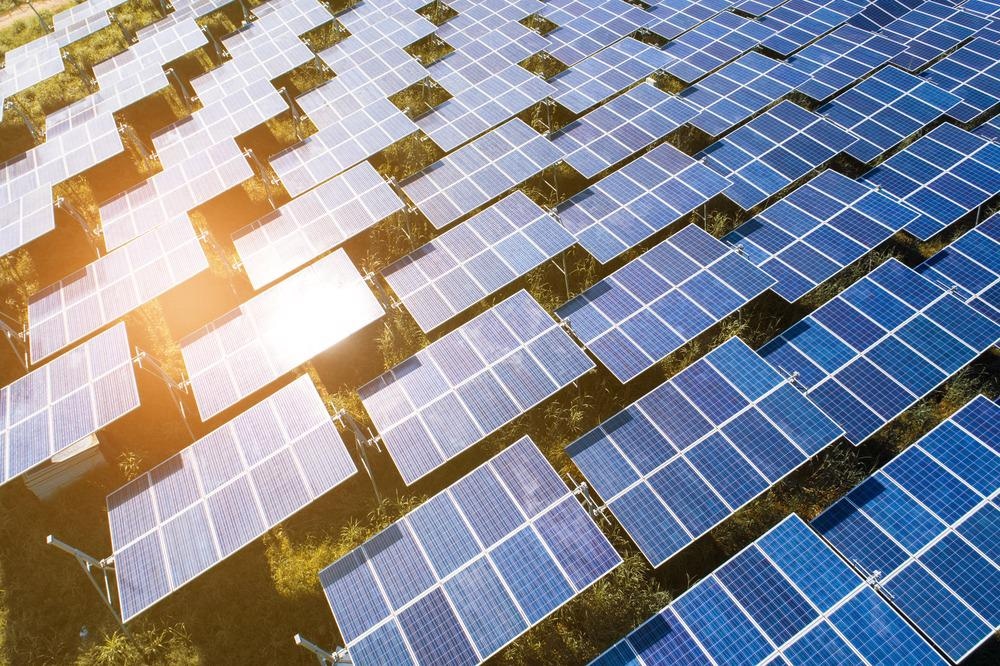A group of researchers examined gallium arsenide and silicon nanostructure-based solar cells for energy storage in an article available as a corrected proof in the journal Materials Today: Proceedings.

Study: Anti-reflective nanostructures for Efficiency Improvement of GaAs based Solar Cells. Image Credit: Thongsuk7824/Shutterstock.com
Using COMSOL Multiphysics and Numerical Simulation computations, the absorption spectrum capabilities of triangular, ellipsoidal, and curved nano-cone shapes employed as anti-reflection coatings were investigated.
The photonic effects of several nanostructures on the FTO substrate with a specific wavelength of the visible region were investigated.
When compared to alternative nanostructures, curved nano-cone formations can attain a higher absorption coefficient. Moreover, as compared to Si-based nanostructures, (GaAs)-based solar cell nanostructures have higher absorption properties.
Strategies to Enhance the Absorption Properties of Solar Cells
Optimizing solar cell surface reflection effectiveness while simultaneously increasing spectral absorption performance will be required to accelerate the manufacturing of high-efficiency solar cells.
To improve the absorption performance of the solar cells, a variety of strategies, such as multiple layer anti-reflective coatings, coherent delocalized oscillations, and microstructures configurations, have been developed.
Limitation of Anti-Reflective Coatings
Even though they have great absorbance amplification capacity, antireflection coatings of various materials suffer from spectral distinctiveness, making it difficult to achieve a broad absorption spectrum as a result.
Utilization of Nanostructures for Enhancing Absorption Performance
A broad range of nanostructures, such as nanorods, nano-cones, and nano-pyramids, are being investigated to enhance the light-harvesting and absorption efficiency of solar cells due to their remarkable anti-reflective characteristics.
These nanostructures also have a broad connection region and efficient routes for efficient electron transport dispersion and transfer. They also have several advantages, including decreased wastage, which leads to cost reductions, a lower volumetric fill factor, and improved power density.
Benefits of GaAs Nanostructures
The optical characteristics of GaAs, which is a group III-V material, are gaining significance. These materials have a high capacitance, a significant broad bandgap, and high carrier mobility, which make them a superlative candidate for optoelectronic devices such as solar cells.
Recently, it has been discovered that GaAs nanostructured photocathode can be used as an electrode material for solar energy conversion devices, which is a promising development. According to the results, the altered product's structure can enhance the photocathode's light-emitting performance.
The gradient reflection coefficient profile of nanostructures, as well as a variety of light dispersion processes from the edges, further improve light entrapment and the refractive indices of trapped photons.
Simulation Methodology
COMSOL Multiphysics program, which employs the finite element technique to find solutions, was used to simulate the models in this study. It is a quantitative method for resolving problems requiring the partition of a big system into minor components that are used in the field of engineering.
A simulation with a substrate thickness of 500 nm and breadth of 2000 nm was used for the computation, and the results were encouraging. The applied electric dispersion at ranges of 300 nm, 500 nm, and 800 nm, as well as the optical absorption spectrum, were all determined with the aid of the Pulse Optics System in this research.
A simulation analysis of GaAs-solar cells is presented in this research. Three nanostructures are considered, with the morphologies of a triangular, a hemispheric, and a truncated nano-cone, respectively.
The photon-catching efficiency of the developed solar cells is enhanced by the inclusion of these three features. For these three structures, the researchers estimated the electrostatic potential and absorptance spectrum using a finite element method.
Research Findings and Conclusion
Using Simulation Tool, the researchers constructed and evaluated triangular, ellipsoidal, and curved cone-shaped nanostructure-based GaAs and Si solar cells.
To investigate the light absorption characteristics of various nanostructured anti-reflective layers. For each structure, they examined the absorption coefficient, electromagnetic field distribution, and photonic open circuit conductivity.
The light absorption performance of nanostructured-based antireflection layers had improved, and the truncated cone surpasses the other two structures in terms of light absorption and carrier production.
Regardless of the structure of the antireflecting layer, GaAs-based SCs display relatively better photonic Solar cell efficiency due to larger and uniform absorptance spectra. This research's calculated analysis, can aid in determining the most effective nanostructure-based antireflection surface for enhanced light entrapment and absorption.
Reference
Kumar Tenwar, A., Singh, S., Mal, I. and Prakash Samajdar, D., (2022) Anti-reflective nanostructures for Efficiency Improvement of GaAs based Solar Cells. Materials Today: Proceedings. https://www.sciencedirect.com/science/article/pii/S221478532200743X?via%3Dihub
Disclaimer: The views expressed here are those of the author expressed in their private capacity and do not necessarily represent the views of AZoM.com Limited T/A AZoNetwork the owner and operator of this website. This disclaimer forms part of the Terms and conditions of use of this website.